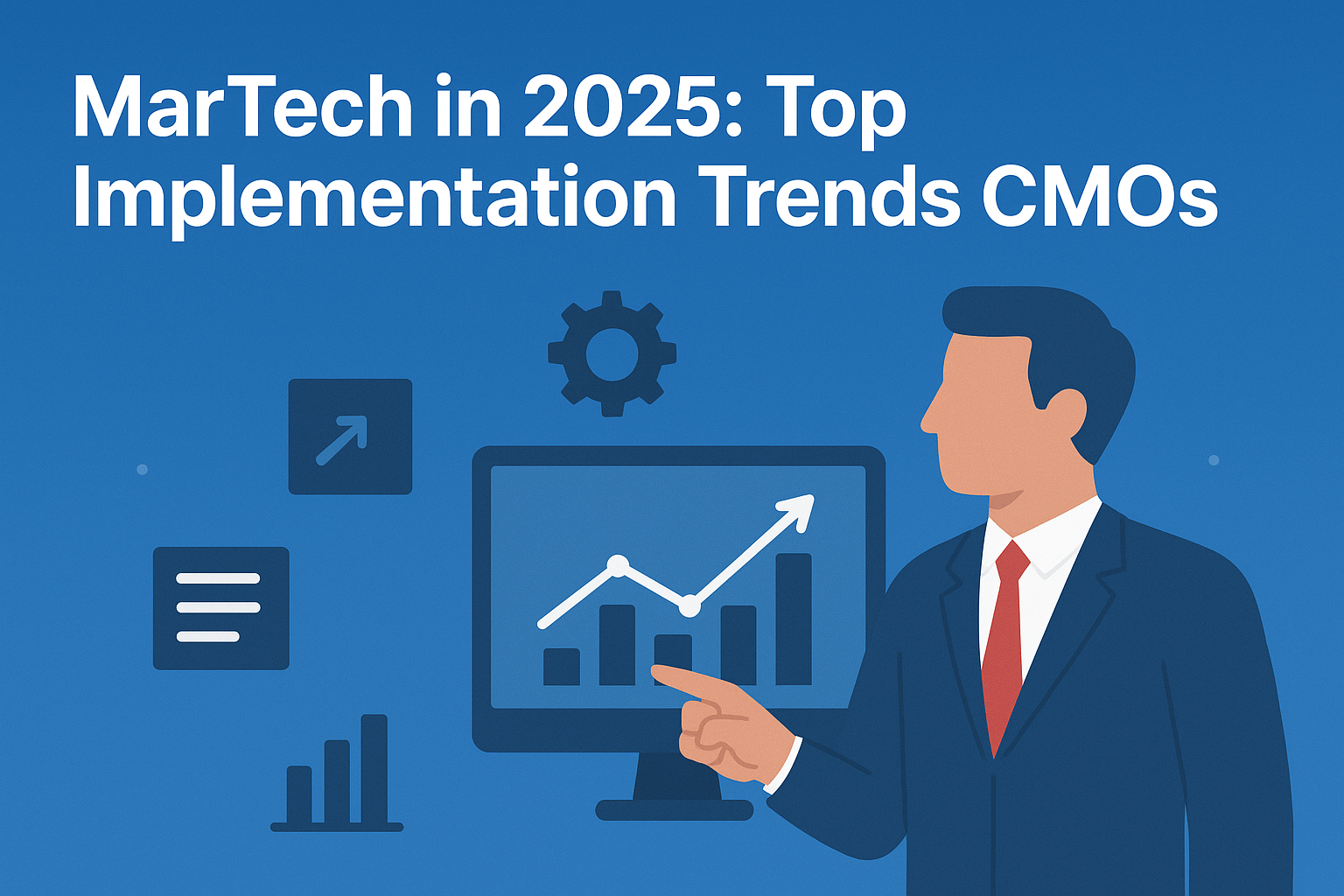
MarTech in 2025: Top Implementation Trends CMOs Can’t Ignore
As marketing landscapes evolve, the role of technology in driving business growth has become undeniable. Marketing technology, or MarTech, is no longer just an added toolset; it is the backbone of how modern marketing strategies take shape. For Chief Marketing Officers aiming to stay competitive in 2025, understanding the key trends in MarTech implementation is essential. This is where a strategic, methodical approach comes into play.
Product Siddha helps businesses implement intelligent MarTech solutions, connecting the dots between strategy and execution. The challenge many face is not the lack of tools but knowing how to integrate them meaningfully. The landscape shifts fast, and knowing which trends matter most can be the difference between leading the market and playing catch-up.
What Is Driving the Evolution of MarTech Implementation?
Marketing technology has expanded far beyond simple email automation or CRM management. Today’s MarTech stacks are sophisticated ecosystems, combining customer data platforms, automation engines, behavioral analytics, and multichannel campaign orchestration. The convergence of data insights, automation, and personalized engagement enables brands to operate more effectively and connect more deeply with their audiences.
A central reason for the growing complexity of MarTech is the sheer volume of customer touchpoints now available. In 2025, consumers expect seamless experiences across websites, mobile apps, social channels, and even voice interfaces. Implementing a MarTech strategy now requires more than plugging in a new tool; it requires an architecture where every part communicates intelligently.
Where Are Most CMOs Investing Their MarTech Budgets in 2025?
The focus has shifted toward platforms that unify customer data, automate workflows, and provide actionable insights. Tools such as HubSpot, MoEngage, and Klaviyo dominate because they offer more than basic functionality; they deliver a complete view of the customer journey.
Product Siddha works closely with these platforms to ensure smooth integration. By connecting a company’s CRM with automation tools and customer engagement platforms, CMOs can focus less on technical hurdles and more on strategic outcomes.
For example, a fintech company seeking to grow its partner network will need a robust CRM setup that manages relationships effectively while using automation to nurture leads. A well-implemented HubSpot Marketing Hub makes this possible by centralizing data and simplifying campaign management.
Similarly, eCommerce brands gain a significant advantage by deploying Klaviyo for automated SMS and email marketing. This is especially effective when connected with customer behavior data from platforms like Customer.io, enabling targeted outreach based on purchase patterns.
When Should CMOs Reevaluate Their MarTech Stack?
Timing is critical. Many organizations delay revisiting their MarTech setup until performance stagnates or technical issues emerge. Instead, a proactive mindset is necessary. CMOs should evaluate their stack at least annually, aligning it with evolving business goals and emerging technology trends.
In 2025, companies that regularly assess the efficiency of their MarTech ecosystem stand out. Are integrations working seamlessly? Is data flowing without silos? Are automation rules enhancing productivity or creating bottlenecks? These questions should form part of a regular strategic review.
Product Siddha’s approach emphasizes ongoing support and optimization after the initial implementation. Continuous improvement is key to ensuring that MarTech tools not only work in isolation but also function as a cohesive system.
Why Are Unified Customer Data Platforms Essential Now?
The single greatest challenge for most companies is fragmented customer data. Without a unified data platform, customer profiles remain scattered across tools, making meaningful insights difficult to achieve. In 2025, the emphasis is on building a centralized customer data platform (CDP) that integrates inputs from multiple sources: website analytics, email engagement, mobile interactions, and social media behavior.
Twilio Segment is one of the leading solutions for this need. It helps businesses collect, unify, and activate customer data in real time, providing a holistic view of customer interactions. With accurate data driving decision-making, marketing teams can create highly personalized campaigns that deliver the right message to the right person at the right time.
The practical role of unified data is seen in advanced segmentation and predictive analytics. Instead of batch-sending a single email campaign, marketers can trigger specific actions when a user exhibits certain behaviors, such as abandoning a cart or visiting a pricing page.
How Are AI and Automation Reshaping MarTech Implementation?
Automation in MarTech is no longer limited to scheduling emails or managing contact lists. Advanced AI algorithms now analyze vast data sets to predict customer behavior and recommend the next best action. Tools like MoEngage and CleverTap exemplify this shift by providing behavior-driven automation, allowing marketers to deliver messages based on user interaction rather than predefined schedules.
CMOs should prioritize implementing AI-driven automation systems that adapt in real time. This reduces reliance on manual adjustments and allows marketing teams to focus on strategic decision-making. For instance, automating customer retention strategies based on engagement patterns increases efficiency and reduces churn without manual oversight.
Product Siddha specializes in setting up these automation engines, ensuring that businesses achieve real-time responsiveness without the typical technical complexity.
What Are the Risks of Poor MarTech Implementation?
A poorly implemented MarTech stack results in data silos, inconsistent messaging, and wasted resources. Rather than enhancing productivity, it complicates workflows and hampers growth. The most common problems arise when tools are used in isolation without a clear integration strategy, leaving customer insights fragmented and underutilized.
For example, a business using separate email marketing tools and CRMs without integration faces duplicated efforts and misaligned communications. Instead of gaining insights into customer preferences, marketers see conflicting data, reducing the impact of campaigns.
The Role of Expert Partnerships in Successful Implementation
No organization should attempt complex MarTech implementations without guidance. Partnering with an AI Automation Agency like Product Siddha ensures access to expertise in tools, strategy, and ongoing support. The experience reduces the trial-and-error phase, accelerates implementation timelines, and drives measurable results.
Product Siddha’s services focus on aligning technical solutions with business objectives. From integrating Customer.io to setting up bespoke dashboards, the approach is tailored to each company’s needs, providing clarity and purpose rather than overwhelming choice.
Implementing a successful MarTech strategy in 2025 is a task that requires foresight, discipline, and expert guidance. CMOs must focus on integrating their technology stack in a way that enhances customer understanding, automates key processes, and generates actionable insights.
With a clear focus on unified data platforms, intelligent automation, and seamless integration, organizations can expect more efficient marketing operations and improved ROI. Rather than chasing every new tool, the priority should be setting up a coherent system that delivers sustainable results.
Product Siddha offers the expertise and solutions necessary to navigate this complex landscape, transforming MarTech implementation from a daunting challenge into a strategic advantage.
FAQs – MarTech Implementation in 2025
1. What is MarTech implementation, and why is it important for businesses in 2025?
MarTech implementation refers to the process of setting up and integrating marketing technology tools such as CRMs, automation platforms, customer data platforms, and analytics solutions. In 2025, it is essential because it enables businesses to deliver personalized experiences, automate repetitive tasks, and make data-driven decisions that improve efficiency and ROI.
2. Which tools are essential for a successful MarTech stack?
A successful MarTech stack typically includes CRM platforms like HubSpot, customer engagement tools such as MoEngage and Customer.io, ecommerce-focused tools like Klaviyo, and data unification platforms like Twilio Segment. The right combination depends on the company’s size, industry, and specific marketing goals.
3. How does AI automation fit into modern MarTech strategies?
AI automation helps analyze large volumes of customer data in real time, identify patterns, and automate actions based on behavior. This reduces the need for manual intervention, improves personalization, and enables real-time responses to customer interactions, enhancing efficiency and engagement.
4. When should a company consider reevaluating its MarTech stack?
Companies should reevaluate their MarTech stack at least annually or when performance issues arise. Major business shifts, customer behavior changes, or new technological advancements also warrant a reassessment to ensure the stack remains aligned with strategic goals.
5. How can partnering with an AI Automation Agency enhance MarTech implementation?
An AI Automation Agency like Product Siddha brings specialized expertise in integrating complex technology stacks, optimizing workflows, and ensuring tools work in harmony. This reduces implementation risk, accelerates time to value, and helps businesses avoid common pitfalls associated with managing MarTech independently.
